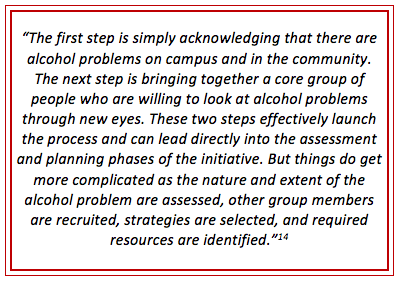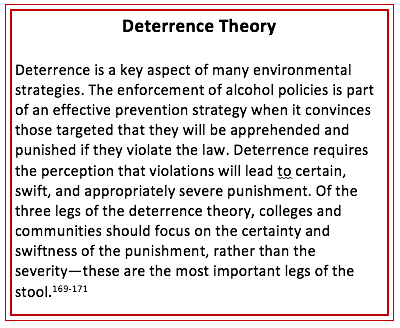Environmental-level Strategies
Overview
College campuses and students are part of their surrounding communities. Alcohol use and related problems that affect students on campus also affect the surrounding community. College administrators can influence conditions on campus and in the surrounding neighborhoods, towns, and cities. They can encourage changes in local and state policies as part of a comprehensive effort to reduce alcohol use on campuses.168
These changes, often referred to as “environmental strategies” because they influence the conditions in which people make their decisions about alcohol use, can reduce excessive alcohol use and related harms among college students, including those who are under the minimum legal drinking age (MLDA) of 21 as well as those who are older. These strategies include alcohol policies and evidence-based interventions implemented either on or off campus.
This is where the campus-community coalition described at the beginning of this Guide is so critical. Many of these strategies cannot be implemented by campuses working alone—they require communication and collaboration with off-campus constituencies and leadership. And, the more on- and off-campus practices and policies that are consistent with each other, the easier it is for students to comprehend and interpret the normative climate around drinking as one supportive of health and safety and discouraging of abuse.
It is important to recognize that all of these strategies should be accompanied by proactive enforcement of alcohol laws, using deterrence theory. This will insure that once implemented, these strategies will be enforced and students will recognize that there are consequences associated with breaking the policy.
The NIAAA Task Force on College Drinking issued a Call to Action in 2002 to change the culture of college drinking.172 They suggested that colleges and universities implement evidence-based strategies using a comprehensive three-in-one framework that targets “1) individuals, including at-risk or alcohol-dependent drinkers; 2) the student population as a whole; and 3) the college and the surrounding community” simultaneously.
An assessment conducted six years after NIAAA issued its recommendations tracked progress in implementing strategies at more than 350 four-year U.S. colleges.173 Approximately one-fifth of the colleges were not even aware of the recommendations; about two-thirds of schools reported that they offered intervention programs for problem-drinkers, a strategy termed effective by NIAAA. However, 22% of colleges referred students to an off-campus facility and did not cover the related expenses, and another 11% did not report having any intervention programs. Colleges also infrequently reported collaborating with communities on environmental strategies that NIAAA found effective: 33% reported conducting compliance checks, 7% regulated alcohol outlet density, and only 2% collaborated in increasing alcohol prices.
In 2015 the NIAAA published the College Alcohol Intervention Matrix (CollegeAIM) to help college personnel create unique, comprehensive, campus-specific alcohol intervention strategies.174 The CollegeAIM provides a range of individual- and environmental-level policy options aimed at reducing underage and excessive drinking among college students. These policies are ranked in the CollegeAIM according to effectiveness, evidence-base, and cost; each policy is accompanied by information on barriers to effectiveness, the staffing required for policy enactment and implementation, and other factors. All of the evidence-based environmental policy strategies included in CollegeAIM as well as others are covered in greater depth below.
It is evident that more progress needs to be made nationwide in implementing evidence-based environmental strategies to reduce excessive drinking and related harms among college students. This section describes strategies and policies that, as part of a multi-component strategic plan, can complement and support interventions being made at the individual and social network levels.



